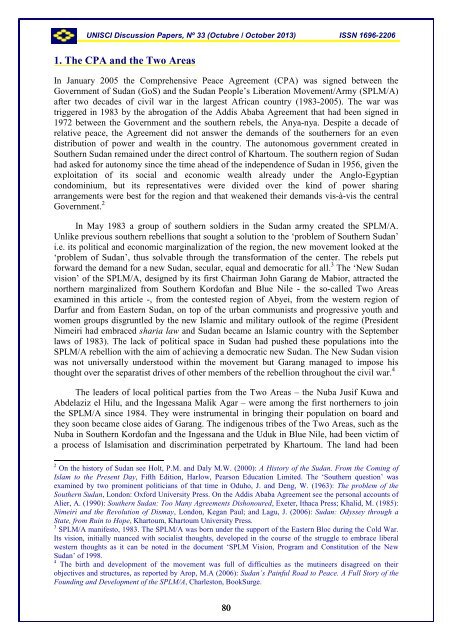UNISCI - Universidad Complutense de Madrid
UNISCI - Universidad Complutense de Madrid
UNISCI - Universidad Complutense de Madrid
You also want an ePaper? Increase the reach of your titles
YUMPU automatically turns print PDFs into web optimized ePapers that Google loves.
<strong>UNISCI</strong> Discussion Papers, Nº 33 (Octubre / October 2013) ISSN 1696-22061. The CPA and the Two AreasIn January 2005 the Comprehensive Peace Agreement (CPA) was signed between theGovernment of Sudan (GoS) and the Sudan People’s Liberation Movement/Army (SPLM/A)after two <strong>de</strong>ca<strong>de</strong>s of civil war in the largest African country (1983-2005). The war wastriggered in 1983 by the abrogation of the Addis Ababa Agreement that had been signed in1972 between the Government and the southern rebels, the Anya-nya. Despite a <strong>de</strong>ca<strong>de</strong> ofrelative peace, the Agreement did not answer the <strong>de</strong>mands of the southerners for an evendistribution of power and wealth in the country. The autonomous government created inSouthern Sudan remained un<strong>de</strong>r the direct control of Khartoum. The southern region of Sudanhad asked for autonomy since the time ahead of the in<strong>de</strong>pen<strong>de</strong>nce of Sudan in 1956, given theexploitation of its social and economic wealth already un<strong>de</strong>r the Anglo-Egyptiancondominium, but its representatives were divi<strong>de</strong>d over the kind of power sharingarrangements were best for the region and that weakened their <strong>de</strong>mands vis-à-vis the centralGovernment. 2In May 1983 a group of southern soldiers in the Sudan army created the SPLM/A.Unlike previous southern rebellions that sought a solution to the ‘problem of Southern Sudan’i.e. its political and economic marginalization of the region, the new movement looked at the‘problem of Sudan’, thus solvable through the transformation of the center. The rebels putforward the <strong>de</strong>mand for a new Sudan, secular, equal and <strong>de</strong>mocratic for all. 3 The ‘New Sudanvision’ of the SPLM/A, <strong>de</strong>signed by its first Chairman John Garang <strong>de</strong> Mabior, attracted thenorthern marginalized from Southern Kordofan and Blue Nile - the so-called Two Areasexamined in this article -, from the contested region of Abyei, from the western region ofDarfur and from Eastern Sudan, on top of the urban communists and progressive youth andwomen groups disgruntled by the new Islamic and military outlook of the regime (Presi<strong>de</strong>ntNimeiri had embraced sharia law and Sudan became an Islamic country with the Septemberlaws of 1983). The lack of political space in Sudan had pushed these populations into theSPLM/A rebellion with the aim of achieving a <strong>de</strong>mocratic new Sudan. The New Sudan visionwas not universally un<strong>de</strong>rstood within the movement but Garang managed to impose histhought over the separatist drives of other members of the rebellion throughout the civil war. 4The lea<strong>de</strong>rs of local political parties from the Two Areas – the Nuba Jusif Kuwa andAb<strong>de</strong>laziz el Hilu, and the Ingessana Malik Agar – were among the first northerners to jointhe SPLM/A since 1984. They were instrumental in bringing their population on board andthey soon became close ai<strong>de</strong>s of Garang. The indigenous tribes of the Two Areas, such as theNuba in Southern Kordofan and the Ingessana and the Uduk in Blue Nile, had been victim ofa process of Islamisation and discrimination perpetrated by Khartoum. The land had been2 On the history of Sudan see Holt, P.M. and Daly M.W. (2000): A History of the Sudan. From the Coming ofIslam to the Present Day, Fifth Edition, Harlow, Pearson Education Limited. The ‘Southern question’ wasexamined by two prominent politicians of that time in Oduho, J. and Deng, W. (1963): The problem of theSouthern Sudan, London: Oxford University Press. On the Addis Ababa Agreement see the personal accounts ofAlier, A. (1990): Southern Sudan: Too Many Agreements Dishonoured, Exeter, Ithaca Press; Khalid, M. (1985):Nimeiri and the Revolution of Dismay, London, Kegan Paul; and Lagu, J. (2006): Sudan: Odyssey through aState, from Ruin to Hope, Khartoum, Khartoum University Press.3 SPLM/A manifesto, 1983. The SPLM/A was born un<strong>de</strong>r the support of the Eastern Bloc during the Cold War.Its vision, initially nuanced with socialist thoughts, <strong>de</strong>veloped in the course of the struggle to embrace liberalwestern thoughts as it can be noted in the document ‘SPLM Vision, Program and Constitution of the NewSudan’ of 1998.4 The birth and <strong>de</strong>velopment of the movement was full of difficulties as the mutineers disagreed on theirobjectives and structures, as reported by Arop, M.A (2006): Sudan’s Painful Road to Peace. A Full Story of theFounding and Development of the SPLM/A, Charleston, BookSurge.80
















